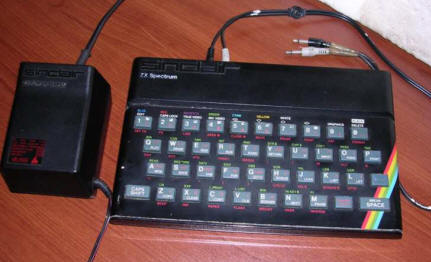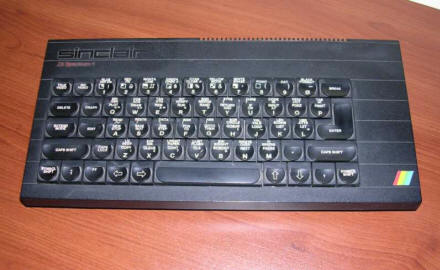ZX Spectrum
Probably the most popular microcomputer - ZX Spectrum was simple, cheap and universal. In Poland it was used in schools, universities, ofices and homes. The main downfall of this computer was a rubber keyboard, not much comfortable in text processing and with short life cycle. This computer is so popular that in many engineering books from 80s all computing programs are in Spectrum's BASIC.
| Manufacturer | Sinclair Research | |
| Origin | UK | |
| Year of unit | 1983 | |
| Year of introduction | 1982 | |
| End of production | 1984 | |
| CPU | Z80A | |
| Speed | 3.5MHz | |
| RAM | 48K | |
| ROM | 16kB (Basic) | |
| Colors: | 8+8=16 | |
| Sound: | 1-bit beeper | |
| OS: | BASIC | |
| Display modes: | Text: 32x24 Graphics: 256x192 |
|
| Media: |
Tape recorder |
|
|
Power supply: |
||
|
A female DC Jack on the computer
1 - +9V DC 1.4A unregulated |
||
| I/O: | Tape in Tape out Expansion bus RF out. |
|
| Possible upgrades: | Many. Early 16K models can be upgraded to 48K. | |
|
It's quite normal that power supply without any load gets ~13.5V. |
||
| Accessories in collection: | ||
| Software accessibility: | Easy (TOSEC, dedicated sites) |
ZX Spectrum Plus
Inside it's a normal ZX Spectrum. There were even DIY kits to transform a normal ZX Spectrum to Plus. But it has improved case: Better cooling, so ULA is not overhetaing anymore, and better keyboard - with full-size keys and separate arrow keys. At last a reset switch was added to prevent the user damaging the computer by disconnecting and re-connecting power supply.
| Manufacturer | Sinclair Research | |
| Origin | UK | |
| Year of unit | 1986 | |
| Year of introduction | 1984 | |
| End of production | 1992 | |
| CPU | Z80A | |
| Speed | 3.5MHz | |
| RAM | 48K | |
| ROM | 16kB (Basic) | |
| Colors: | 8+8=16 | |
| Sound: | 1-bit beeper | |
| OS: | BASIC | |
| Display modes: | Text: 32x24 Graphics: 256x192 |
|
| Media: |
Tape recorder |
|
|
Power supply: |
||
|
A female DC Jack on the computer
1 - Ground |
||
| I/O: | Tape in Tape out System bus expansion RF out. |
|
| Possible upgrades: | Many known | |
|
It's quite normal that power supply without any load gets ~13.5V. |
||
| Software accessibility: | Easy (TOSEC, dedicated sites) |
My Spectrum+ is imported to Poland by P.Z. Apina. There were problems with getting western micros to Poland because of limitations introduced by US (and other western european countries) governments to prevent communist countries getting western technologies. P.Z. Apina imported parts, not computers: Casings, keyboards, complete mainboards, power supply units - it was easier to import it, and they assembled complete computers (sometimes they added display units, for example Neptun 156) in Poland. One of my Plus has a strange video output circuitry (made using Polish parts), designed to help distinguish colors on monochrome screen. Yes, it makes a small difference in color's brightness making it better to read on a green-phosphorized screen, but it's not a great thing.
| Contents: | Starting | Image file formats | Recording media | Pinouts | Links |
Starting:
It boots directly to BASIC. Now you can LOAD and SAVE
progams.
Loading the first program from cassette is LOAD"".
If you want to type BASIC keywords, you have to type only the first
character of it - it'll pop on the screen.
Image file formats:
Tapes:
- TZX - Tape pulse image.
- TAP - Optimized sound file, so it'll work for many computer programs,
Spectrum too.
- Z80 - Memory snapshot. May be converted with Z802TZX.
- SLT - Another snapshot format, I think it may be converted using
emulator loading it and creating a Z80 snapshot.
- SNA - Snapshot - can be converted using SPConv.
Micro tape cartridges:
- MDR - Microdrive Cartridge Image - Can be
converted to tape using MDR2TAP.
- WDR - Wafadrive image. Rare.
Disks:
- TRD - TR-DOS Disk image, used widely on Scorpion
or Pentagon ZX Clones.
- OPD - Opus Discovery image - Utilities are
here.
- DSK - Spectrum +3 Disk format
Cartridges:
- ROM - ROM dump.
Recording media
Recording tapes is easy - you generate sound on PC and record it to tape. If you connect PC sound card's output directly to Spectrum and tune it good, you'll get a program into your Speccy without a tape.
To play it, you can use WinTZX or TZX2WAV. For older computers I recommend TAPER, I checked it and it works well.
Pinouts:
5-pin DIN female socket:
Tape is always: 1: Ground, 2:Tape i/o.
Video connector is female chinch-type one, shield is ground.
Expansion edge connector pinout:
|
|
||
| Component side: | Solder side: | |
| 1 2 3 4 5 6 7 8 9 10 11 12 13 14 15 16 17 18 19 20 21 22 23 24 25 26 27 28 |
A15 A13 D7 NC [key] D0 D1 D2 D6 D5 D3 D4 INT NMI HALT MREQ IORQ RD WR -5V DC WAIT +12V DC 12V AC M1 RFSH A8 A10 NC |
A14 A12 +5V +9V [key] GND GND CLOCK A0 A1 A2 A3 IORQGE GND VIDEO Y V U BUSRQ RESET A7 A6 A5 A4 ROMCS BUSACK A9 A11 |
Links:
http://www.worldofspectrum.org - ZX Spectrum website - Documentation,
Games archive, resources.
http://web.archive.org/web/20110828210908/http://www.wearmouth.demon.co.uk/ - Partial ZX Spectrum ROM
disassembly
http://zxgate.sourceforge.net/
- ZX Spectrum into FPGA project.
http://web.archive.org/web/20120219051428/http://sinclair.focus.pl/ - One
of the last surviving Polish ZX Spectrum sites, now only archived.
http://www.fizyka.umk.pl/~jacek/zx/ - Another Polish site. Last
update: 2000. Links are good base for dead web page research.
http://www.nvg.ntnu.no/sinclair/ - Planet Sinclair - Here you can
get known everything about Sinclair Research and its devices.
http://echorod.home.xs4all.nl/zx/index.htm - Sinclair hardware
information
http://tarjan.uw.hu/zxclones_en.htm - ZX Spectrum in 21st Century -
Information about Spectrum and its clones.
http://web.archive.org/web/20140518021442/http://newton.sunderland.ac.uk/~specfreak/ - Speccy page from about
1999. If you think my website looks ancient - That's how an ancient
website looks like.







